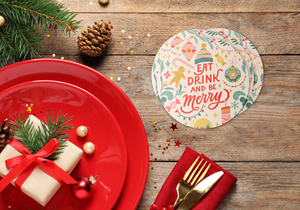Designing Hot Sauce Labels that Sizzle

Sure, a hot sauce’s flavor might win hearts, but it’s the label that draws customers in for a taste. A hot sauce label that’s eye-catching, fun, and true to your brand can make all the difference in a crowded market, turning casual browsers into loyal heat-seekers.
Ready to spice things up? Here’s a guide to creating hot sauce labels that pack a punch and show off what makes your brand one of a kind.
Start with a Clear Brand Identity
Before jumping into the label design, make sure you’re clear on what your brand is all about. Is your hot sauce bold and fiery, or maybe it has a unique twist on classic flavors? Your label should tell that story at first glance.
Here’s what to keep in mind:
- Tone: Are you all about edgy vibes or more of a rustic, down-to-earth feel? The label should reflect that.
- Audience: Who’s buying your hot sauce? Adventurous foodies? Heat lovers? Make sure your design speaks their language.
- Color Scheme: Reds, oranges, and yellows are classics for heat, but don’t be afraid to try something new if it fits your vibe.
Nailing down your brand identity first will make every design choice easier and keep your labels looking sharp and consistent.
Choose Colors That Pop and Pack a Punch
Colors do a lot of the heavy lifting in hot sauce label design. They set the mood, make your bottle pop on the shelf, and give customers a hint about the flavor inside.
Here’s a quick rundown:
- Red: For sauces that bring the heat. It’s bold, spicy, and commands attention.
- Orange and Yellow: Great for sauces with a milder or tangy kick, like fruit-based flavors.
- Dark Tones: Black or deep browns can add a gourmet feel—perfect for a small-batch or artisanal hot sauce.
Feel free to go beyond the norm with colors, but make sure they play nice with the spicy personality of your sauce.

Pick Fonts that are Bold, Clear, and Full of Character
Fonts aren’t just about readability; they give your label personality. But you’ll want to strike a balance between style and clarity, so customers don’t have to squint to see what’s inside.
- Make Your Brand Name Pop: Your brand name should stand out, so go for a bold font that’s easy to read. Skip the frills here.
- Pair with a Complementary Font: Use a second, simpler font for the flavor name, heat level, and other details.
- Keep It Simple: Two fonts max is the way to go—one for the main name and one for the supporting info.
Your font choices help tell the story of your sauce, so pick styles that add to its personality while making the important details easy to spot.

Add Some Flavor with Imagery and Icons
Want to make your label stand out even more? A few fun visuals can go a long way to help customers connect with your sauce.
- Chili Icons for Heat Levels: Add little chili icons for a quick visual of the spice level—one chili for mild, two for medium, and so on.
- Flavor Icons: If your sauce has mango, habanero, or smoked peppers, consider adding tiny illustrations of these ingredients to hint at the taste.
- Background Patterns: Subtle graphics like flames, peppers, or even geometric patterns add a layer of depth to the label.
These elements give your label personality, making it easy for customers to get a feel for your sauce before they even open the bottle.
Highlight the Essentials (Without Clutter)
It’s not just about style; a hot sauce label has to communicate the basics at a glance. Here’s what to include:
- Brand Name: This should be big and bold.
- Flavor or Heat Level: Make sure customers can quickly see the flavor profile and spice level.
- Ingredients: If you’re using unique or locally-sourced ingredients, list them proudly.
- Volume: Keep the bottle size visible (e.g., “5 fl oz”) in a spot that’s easy to find.
- Contact Info: Add a website, social handle, or QR code for curious customers to learn more.
Organize these details with different font sizes, colors, or borders to keep the label clean and easy to scan.
Show Off Your Unique Selling Points
Got something that makes your sauce special? Let customers know!
- Handcrafted or Small-Batch: Phrases like these signal quality and give your product an artisanal feel.
- Unique Ingredients: If your sauce has organic, local, or rare ingredients, include that info on the label—it’s a selling point!
- Awards and Recognition: Any awards? Show them off! It’s a fast way to build trust.
Your unique selling points can help you stand out on the shelf, so work them into your label design with small icons or stylish text.

Don’t Forget Practical Elements
Hot sauce labels aren’t just about good looks—they’ve got to hold up in the kitchen, too. Here are some practical considerations to keep in mind:
- Material: For most hot sauce labels, paper material will work perfectly for the application. However, if your hot sauce bottles will face moisture, go for a waterproof or oil-resistant label to prevent smudging or peeling.
- Label Shape and Size: Make sure your label fits the bottle shape, whether round, square, or wrap-around. A custom shape can add extra flair, but it needs to fit well.
- Legal Info: Add any necessary compliance details like “Manufactured in…” or allergy info to keep things legit.
With the right materials and design tweaks, your label will look great and last, even after being handled a lot.
Turn Up the Heat on Your Hot Sauce Label Design
An eye-catching hot sauce label does more than look good—it tells your brand’s story and gets customers excited to try your product. By choosing bold colors, memorable fonts, and unique visuals, you can create a label that pops and communicates the essence of your sauce.
Ready to fire up your packaging? Start designing with Stomp today and give your hot sauce a label as hot as its flavor!
FAQs About Hot Sauce Label Design
- What colors work best for hot sauce labels? Reds, oranges, and yellows scream “spicy!” while darker tones like black give a premium vibe.
- How can I show the spice level on my label? Use chili icons or words like “Mild,” “Medium,” and “Hot” to make spice levels clear.
- What material should I use for hot sauce labels? Waterproof or oil-resistant materials are best, keeping labels in top shape even in the kitchen.
- Why does font choice matter in label design? Fonts affect readability and brand vibe. Go bold for the brand name, keep it simple for the rest.
- How does digital printing improve label quality? Digital printing makes colors pop and adds a high-res finish, giving your label a pro look.
- What needs to be on a hot sauce label? Read our in-depth blog article that explains exactly what needs to be included on cottage food products like hot sauce. Also, check out the FDA's extensive guide to food labeling requirements.
- Nashira Edmiston











